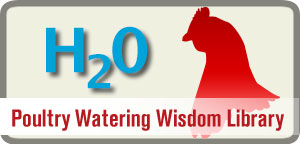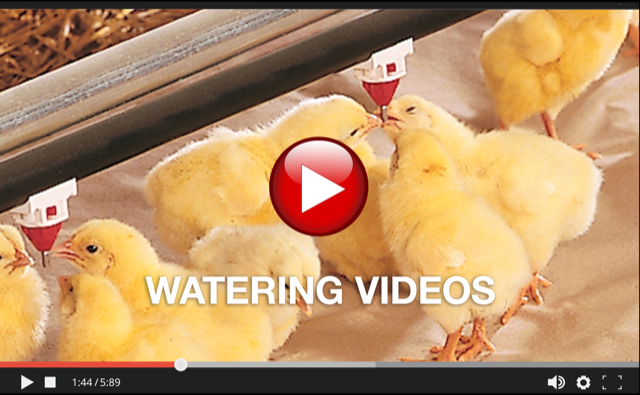It is important to distinguish between water usage as measured by water meter readings over a specific time and the actual consumption of a flock representing the volume of water actually ingested. The difference between use and consumption is represented by spillage.
Although a drinker with a high volume of delivery will satisfy thirst, the water released from a drinker that is not actually swallowed will drain to the litter. The substrate covering the floor usually comprises wood shavings or rice hulls mixed with the excreta from the flock. Litter functions as a sink to absorb spillage and excretion.
The rate of removal of water from litter is a function of the relative temperature and humidity in incoming air and the exchange rate of air in the house, achieved by fan-powered extraction. At humidity levels below 50 percent and with a minimum ventilation rate of 1cfm per pound body weight, excess moisture will be removed from litter and especially under the drinker lines. Spillage occurs as a result of inappropriately high water pressure in the drinker lines, leakage from defective nipples or insecure connections. Spillage may exceed the absorptive capacity of the layer of litter leading to a high moisture level extending to saturation. This is especially evident under conditions of high humidity coupled with low temperature when suboptimal ventilation rates may be selected. Problems of litter saturation arise when ventilation rates are based only on the basis of temperature without reference to humidity levels in incoming air and in the house.
The efficacy of poultry drinking systems should not be measured by static water flow rates but by dynamic release that actually conforms to the water intake requirements of the flock. Many manufacturers of nipple-type drinkers promote the performance of their products by claiming a high static flow rate of water usually expressed as milliliters per minute. These are essentially meaningless figures in the context of satisfying thirst. Chickens peck at the trigger pins to receive a small release of water, most of which should be swallowed. The remainder will be spilled. Ideally the quantity of water ingested should be adequate to satisfy thirst but not so excessive that an appreciable quantity is spilled. Nipple type drinkers must, therefore, supply an adequate but not excessive quantity of water as the birds peck at the drinker’s trigger pin. This satisfies requirements for growth and prevents excessive water deposition on litter. In practice broilers spend less than eight percent of their lighted day to satisfy thirst over a 65F to 80F range in house temperature. With a ratio of 12 to 15 broilers per drinker, distributed over a number of lines based on the width of the house will be adequate to provide ample water to a flock
Excessive drinker discharge due to a high pressure setting in a poultry house is analogous to working on a hot day in the garden and trying to drink from a garden hose. The flow rate will be too high in relation to the volume that can actually be swallowed. Although thirst is satisfied there is considerable wastage spilled onto the ground. In the case of a broiler flock, delivery of more water from a nipple than can be retained in the oral cavity before being swallowed results i spillage with accumulation of water in litter under drinker lines.
Wet litter is problematic for broiler flocks since it is invariably associated with respiratory, intestinal and skin conditions that detract from optimal growth and impair quality. Wet litter favors high levels of bacterial foodborne pathogens that require moisture for persistence and proliferation.
- Intestinal conditions that are adversely affected by wet or damp litter include coccidiosis and clostridial enterotoxemia (necrotic enteritis, cholecystitis-hepatitis). Appropriate control of litter moisture is extremely important in drug-free growing systems that exclude antibiotics in feed to suppress both intestinal proliferation of Clostridium and coccidiosis challenge.
- Damp and wet litter is associated with bacterial degradation of uric acid excreted by birds, resulting in liberation of ammonia. This compound irritates the respiratory mucosa exacerbating the effects of respiratory infections including bronchitis virus and mycoplasmosis. There is ample evidence to show that birds subjected to levels of atmospheric ammonia at levels exceeding 25 ppm at head height have lower growth rates and higher mortality than flocks reared at lower levels of atmospheric ammonia.
- Skin is adversely affected by wet litter. Proliferation of Clostridium in damp litter contributes to gangrenous dermatitis and “hock burn”. Wet litter with liberation of ammonia predisposes flocks to pododermatitis, again reducing growth rate and adversely reducing the value of feet for export.
- Wet litter allows proliferation of Salmonella and Campylobacter that are ingested by the flock colonizing the intestinal tract and coating feathers. This increases the load of these pathogens that contaminate transport modules and are introduced into the plant. High bacterial levels are recovered from scald tanks, de-feathering fingers and E-line installations, elevating the pathogen levels on product.
The return over production costs for a flock is influenced by adequate water and feed intake, freedom from erosive diseases of the intestinal and respiratory tracts and attaining optimal quality of skin and feet. Decades of experience acquired by Ziggity Systems in the design and manufacture of drinking systems contributes to optimal consumption and growth without creating problems of wet litter from spillage.
Amended April 5th 2024












